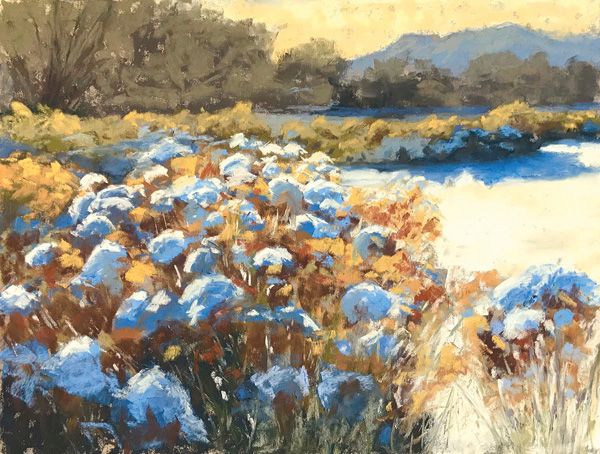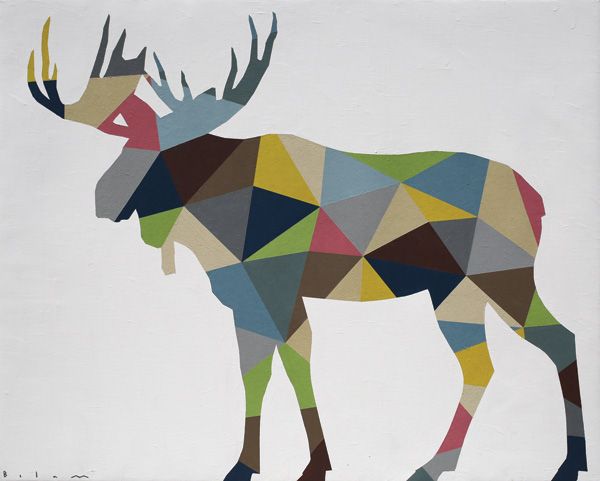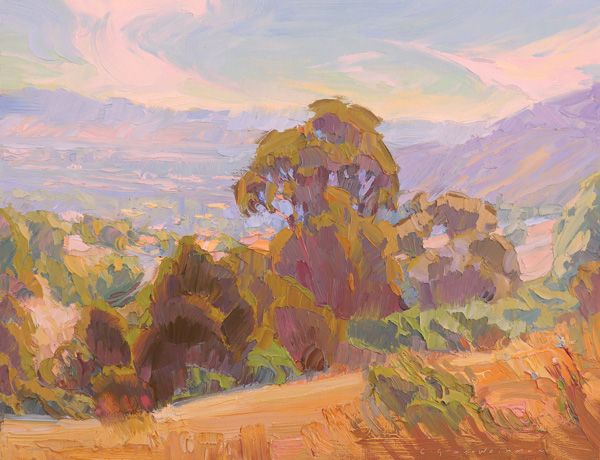Collecting original fine art can be FUN and rewarding; it can ENRICH your home, your spirit, and your life. But it can also, at times, be daunting, PUZZLING, and frustrating. To HELP you reap all of the benefits without suffering any of the pitfalls, we’ve compiled this compendium of some of our ALL-TIME-BEST advice about art collecting. Here’s hoping it inspires you to bring WONDERFUL new artwork into your world.

Ani Espriella, Winter Bouquet, pastel, 9 x 12.
This story was featured in the October 2019 issue of Southwest Art magazine. Get the Southwest Art October 2019 print issue or digital download now–then subscribe to Southwest Art and never miss another story.
DO listen to your heart
You should learn all you can about the market and the artists you like, about galleries, genres, and styles, and perhaps art history itself. But the final word comes down to this: Believe in yourself rather than the so-called experts. Spend your money on art that elicits an emotional response.
DO widen your horizons
You can mix contemporary with traditional art, all on the same wall. Chosen carefully and framed appropriately, it makes a splendid presentation and a lot of times is more interesting than keeping to one style.
DON’T miss out on miniatures
One of the best opportunities for viewing a wide variety of art in an affordable price range is miniatures shows, which are an annual tradition at many galleries and generally feature paintings measuring 9 by 12 inches or smaller. These shows often feature established artists who usually work on a larger scale and in a much higher price range. But for miniatures shows they create jewellike pieces suited for the budgets of beginning collectors.
DO make it personal
Choose respected galleries that have been around a long time and whose personnel are knowledgeable and pleasant to work with. Building a personal relationship with a dealer will make the process of collecting an enjoyable event.
DO stick with an artist for the long haul
Find an established artist you like whose work spans a wide price range. That way you can start with small pieces and aim to eventually obtain more expensive work by the same artist. As your budget grows, you’ll be able to follow the artist’s developing career while adding to your own collection.
DO ask about buying on approval
So you’re convinced you love a particular piece of art. But what if you don’t love it next week? Or what if you see something else a few months later that you really wish you’d bought instead? One way to allay that fear is to take advantage of the policy typical of many galleries: buy a piece on approval with the option of bringing it back for return or exchange within a certain period of time. Just make sure to agree on all of the terms up front.
DO buy plein-air paintings
One way to find excellent art at reasonable prices is to look at plein-air paintings. Because they are done on location, such paintings tend to be smaller and must be painted more quickly than studio work. With less time—but just as much talent—invested in them, plein-air paintings are generally less expensive.
DON’T skimp on information
Become acquainted as much as possible with the breadth of an artist’s body of work rather than a single piece that catches your eye. Getting to know an artist involves gathering biographical information, including how long and consistently the artist has been working, where the artist shows his or her work, whether the artist has been included in museum or juried shows or garnered awards, and how the price of the work has changed over the years.
DON’T limit yourself to paintings
Drawings, etchings, and hand-pulled prints can offer a great opportunity to own very nice pieces by renowned, deceased artists, even when your budget is modest. And when it comes to living artists, they may be priced lower than similarly sized oil paintings.

Andrew Bolam, Alces Alces, acrylic, 46 x 58.
DON’T buy a “name”
Don’t buy a piece solely because it was created by a well-known artist. A high-quality image by a less-well-known artist is a much better buy. The name’s not enough in itself.
DO trust your gut
You don’t have to be a professional art critic in order to be attracted to a particular
artwork—or to recognize when something about a painting or sculpture feels a little bit “off.” Trust your gut feeling and look for work that you truly love.
DON’T worry if you don’t like the frame
Most artists deliver works to their galleries already framed. That doesn’t mean, however, that the frames are always integral to the paintings themselves. Different artists put different amounts of time and money into their frames; some have a custom frame built for each piece, and others use frames they already have on hand. In other words, galleries are well aware that there can be an arbitrary nature to frames. Sometimes it just doesn’t work right for the person’s décor, or even for the piece itself. Galleries across the board are more than happy to change a frame.
DO ask about payment plans
Traditional “layaway” payment plans are almost always an option. Every gallery takes payments, so don’t be too intimidated to ask these kinds of questions. Depending on the price, the gallery, and the artist, a payment schedule may vary from just two monthly payments to three, four, or even more. But remember that the gallery will hang onto the artwork until the final installment has been received.
DO make a plan
At some point in your collecting journey, you may find it useful to devise a plan to guide your future purchases. That way you won’t end up with a collection of works that is, say, more eclectic—or more repetitive—than you had intended. For starters, think about whether you want to collect works by deceased or living artists; this allows you to zero in on specific galleries and auctions. Also, think about the genres, styles, and subject matter that interest you. Some collectors acquire numerous works by a single artist; others might love, say, wildlife art in all its forms. There’s no right or wrong approach.
DO consider a commission
When you have a specific concept in mind for a painting or sculpture, it can make sense to commission an artist to execute that concept. It could be, for example, a scenic view from your property, or a portrait of a family member or pet. Many artists accept commissions, but not all. And commissions can cost more. It can be helpful to work with a gallery to facilitate the commission, and it’s a good idea to ask the artist for a preliminary sketch or study, which you can approve before the artist begins work on the larger, final version of the artwork.
DON’T be a bargain hunter
Exactly the wrong way to go about starting a collection is to hunt for bargains and choose quantity over quality. Often what seems like a bargain at first ends up under the bed.

Carole Gray-Weihman, Sweeping Parade, oil, 12 x 16.
DON’T buy for investment
No reputable gallery will make any claims that the art they sell is a sound financial investment. Nobody knows what’s going to
appreciate—there’s just no way to figure that out. Some artists’ works may skyrocket in price, while others remain flat or fall. Gallerists advise that a combination of careful consideration and patience will generally help ensure that an investment in good art won’t lose money—as long as the collector chooses thoughtfully and hangs onto the work for the long haul. Most likely a piece will retain its value, and you’ll get a lifetime of enjoyment. Ultimately, personal pleasure—not profit—should be the point of collecting.
DO educate yourself
Visit as many galleries as possible. Invest in museum-quality art books and study them. Take the time to look at artwork in museums and galleries, and you’ll eventually develop a sense of what’s good and what’s not—
without having to go to art school.
This story was featured in the October 2019 issue of Southwest Art magazine. Get the Southwest Art October 2019 print issue or digital download now–then subscribe to Southwest Art and never miss another story.
MORE RESOURCES FOR ART COLLECTORS & ENTHUSIASTS
• Subscribe to Southwest Art magazine
• Learn how to paint & how to draw with downloads, books, videos & more from North Light Shop
• Sign up for your Southwest Art email newsletter & download a FREE ebook





